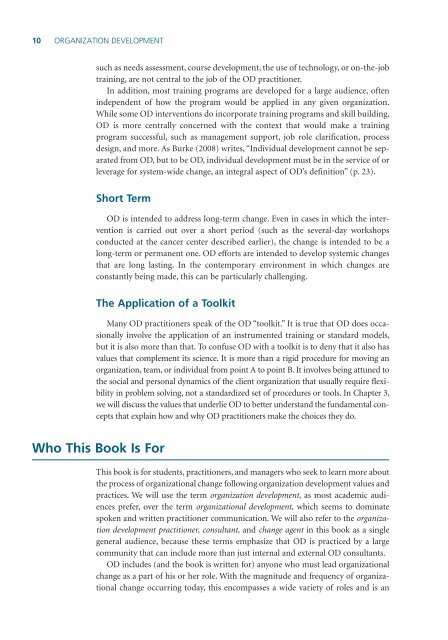Organizational Development - Vol. V, Part II
Organizational Development - Vol. V, Part II
Organizational Development - Vol. V, Part II
Create successful ePaper yourself
Turn your PDF publications into a flip-book with our unique Google optimized e-Paper software.
10 ORGANIZATION DEVELOPMENT<br />
such as needs assessment, course development, the use of technology, or on-the-job<br />
training, are not central to the job of the OD practitioner.<br />
In addition, most training programs are developed for a large audience, often<br />
independent of how the program would be applied in any given organization.<br />
While some OD interventions do incorporate training programs and skill building,<br />
OD is more centrally concerned with the context that would make a training<br />
program successful, such as management support, job role clarification, process<br />
design, and more. As Burke (2008) writes, “Individual development cannot be separated<br />
from OD, but to be OD, individual development must be in the service of or<br />
leverage for system-wide change, an integral aspect of OD’s definition” (p. 23).<br />
Short Term<br />
OD is intended to address long-term change. Even in cases in which the intervention<br />
is carried out over a short period (such as the several-day workshops<br />
conducted at the cancer center described earlier), the change is intended to be a<br />
long-term or permanent one. OD efforts are intended to develop systemic changes<br />
that are long lasting. In the contemporary environment in which changes are<br />
constantly being made, this can be particularly challenging.<br />
The Application of a Toolkit<br />
Many OD practitioners speak of the OD “toolkit.” It is true that OD does occasionally<br />
involve the application of an instrumented training or standard models,<br />
but it is also more than that. To confuse OD with a toolkit is to deny that it also has<br />
values that complement its science. It is more than a rigid procedure for moving an<br />
organization, team, or individual from point A to point B. It involves being attuned to<br />
the social and personal dynamics of the client organization that usually require flexibility<br />
in problem solving, not a standardized set of procedures or tools. In Chapter 3,<br />
we will discuss the values that underlie OD to better understand the fundamental concepts<br />
that explain how and why OD practitioners make the choices they do.<br />
Who This Book Is For<br />
This book is for students, practitioners, and managers who seek to learn more about<br />
the process of organizational change following organization development values and<br />
practices. We will use the term organization development, as most academic audiences<br />
prefer, over the term organizational development, which seems to dominate<br />
spoken and written practitioner communication. We will also refer to the organization<br />
development practitioner, consultant, and change agent in this book as a single<br />
general audience, because these terms emphasize that OD is practiced by a large<br />
community that can include more than just internal and external OD consultants.<br />
OD includes (and the book is written for) anyone who must lead organizational<br />
change as a part of his or her role. With the magnitude and frequency of organizational<br />
change occurring today, this encompasses a wide variety of roles and is an

















